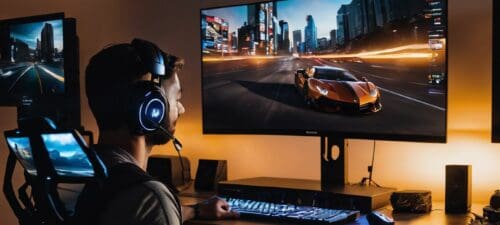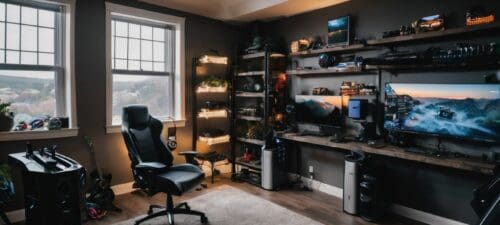Caster Voice Training: Achieve Your Best Voice Actor Performance
Updated On: October 23, 2025 by Aaron Connolly
What Is Caster Voice Training?
Caster voice training helps esports commentators deliver clear, lively commentary during gaming events. It blends classic vocal skills with the chaos and rapid pace of gaming—think fast play-by-play narration and keeping the energy up for the audience.
Defining Caster Voice Training
Caster voice training builds up the vocal chops you need for esports commentary. It’s not quite like voice over work for ads or cartoons. Instead, it gets you ready for live, high-energy game broadcasts.
The training covers breath control—a must for those marathon casting sessions. Some tournaments run 8-12 hours, so you’ve got to keep your voice strong the whole way. We pick up tricks to avoid blowing out our voices during those wild moments.
Key differences from standard voice training:
- Real-time reaction skills
- Delivering gaming lingo
- Managing crowd energy
- Working smoothly with a co-caster
Pro esports casters flip between calm analysis and high-octane play-by-play. That kind of vocal agility takes practice and muscle memory.
Training often throws you right into live game footage. Students cast over real matches to build up the skills they’ll actually use. This hands-on approach feels pretty different from the usual script-based voice acting classes.
Key Components of Caster Voice Training
Vocal mechanics sit at the core of caster training. We work on breathing from the diaphragm to keep our voices steady through long events. Good posture and knowing how to use a mic keep the audio crisp.
Delivery speed training gets us ready for the breakneck pace of esports. We practice talking fast but still making sense. This comes in handy when a team fight breaks out in League of Legends.
Game knowledge integration makes caster training unique. We have to know the games inside and out to give solid commentary. That means studying popular titles and learning the jargon.
Co-casting chemistry is a big one. Most broadcasts use duos. We learn when to jump in, when to back off, and how to riff off our partner.
Audience engagement techniques teach us how to connect with viewers. We practice talking to the camera, reacting to chat, and keeping things lively—even when the action slows down.
Practice sessions usually crank up the pressure with background noise and strict time limits.
Who Benefits from Caster Voice Training
Aspiring esports commentators get the core skills they need for broadcast gigs. Loads of UK universities now have esports programmes with commentary training. Students can jump in by covering university tournaments.
Content creators and streamers boost their on-air presence for live streams. Training helps them hold viewers’ attention during those long sessions. Plenty of streamers end up moving into casting.
Gaming journalists sharpen their video and podcast work. Voice training makes interviews and on-camera bits stronger. With so much gaming media going video-first, this skill’s pretty valuable.
Tournament organisers sometimes need someone to fill in as a caster. Even basic voice training means staff can step up if needed. Local scenes benefit from having backup commentators ready to go.
Voice actors can branch out into esports casting for extra gigs. The skills overlap, but you’ve got to know your games. More and more voice over folks are working esports events these days.
Quick win: Try watching pro casters with the game sound off. Focus just on how they use their voices and the way they keep things moving.
Understanding the Role of a Caster
A caster brings esports matches to life for viewers everywhere. They team up with casting directors and voice actors to make every broadcast clear and exciting, keeping fans hooked on the action.
What Does a Caster Do?
Casters bridge the gap between complicated gameplay and viewers who need things explained on the fly. Their main job is play-by-play commentary during matches.
You’ll usually see two types of casters. Play-by-play casters call the action as it happens. Colour commentators add analysis and backstory to help everyone understand.
Casters prep hard before tournaments. They watch old games, study team rosters, and keep up with the latest strategies.
Day-to-day, casters:
- Research teams and players
- Practice commentary during scrims
- Coordinate with the production crew
- Improvise when surprises pop up
- Keep their energy up on those long days
During a live show, casters think on their feet and speak clearly. They handle tech hiccups, last-minute player swaps, and unexpected game twists—all without losing the audience.
How Casters Influence Voice Over Casting
Caster performance shapes voiceover casting for big tournaments. Organisers look for clear speech, deep game knowledge, and that spark that connects with viewers.
Casting directors watch for certain vocal qualities. Clear pronunciation helps everyone follow along, especially international audiences. Keeping the energy up keeps fans tuned in through marathon matches.
Key vocal requirements:
| Skill | Why It Matters |
|---|---|
| Projection | Cuts through loud game audio |
| Pace control | Fits the mood, fast or slow |
| Accent neutrality | Makes broadcasts accessible worldwide |
Some experienced casters jump into voice acting for trailers, character work, or promos. Their game smarts add authenticity.
Casting directors often scout esports casters for commercial voiceover gigs. The skills translate pretty naturally from live events to studio sessions.
Collaboration between Casters and Voice Actors
Casters and voice actors sometimes team up for big esports productions. Together, they create a richer experience for the audience.
You’ll notice this most in tournament intros. Voice actors record dramatic openings, and casters handle the live transitions.
Common projects they work on:
- Pre-recorded player intros
- Highlight reel narration
- Sponsored segment voiceovers
- Post-match interviews
Voice actors nail the scripted stuff that takes multiple tries. Casters handle the live, unpredictable moments.
Both jobs need solid vocal training, but they focus on different things. Voice actors dig into character and emotion. Casters focus on consistency and quick analysis.
Production crews coordinate between both roles to keep broadcasts smooth. They make sure voice actor bits blend into live caster commentary without any awkwardness.
Choosing the Right Voice Training Programme
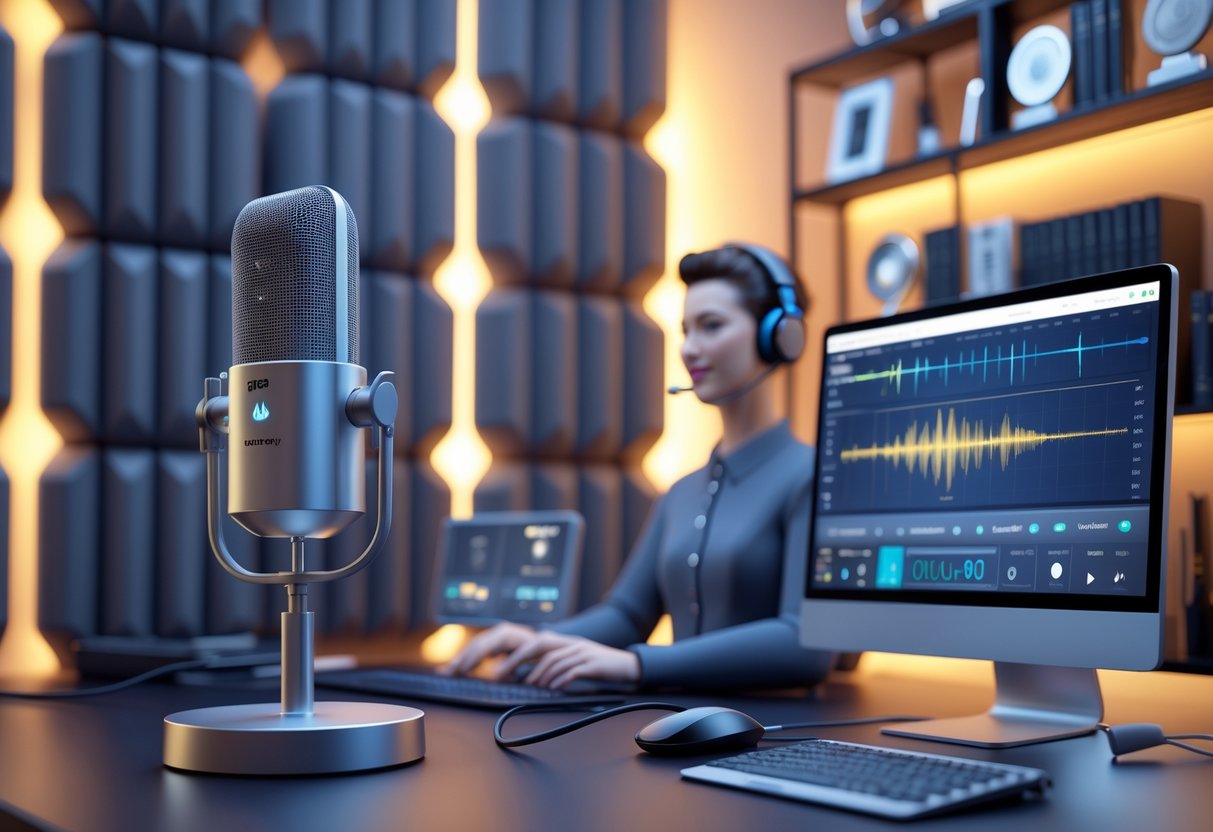
Choosing the right training programme shapes your whole voice acting journey. You’ll need to pick between in-person and online options, check out the instructors, and look into big names like The Voicecaster.
In-Person vs. Online Voice Training
In-person training gives you real-time feedback and hands-on coaching. You get to work in pro studios with proper gear. There’s also a chance to meet other students and industry folks.
The downside? It costs more and you’ll probably have to travel. Sessions happen on a set schedule, which isn’t always convenient.
Online training is more flexible and usually cheaper. You can learn from top coaches no matter where you are. Many courses let you move at your own pace and review lessons as needed.
But you’ll need your own recording setup. Tech issues can get in the way. Some people find it tough without meeting face-to-face.
Cost comparison:
- In-person: £300-£2,000+ for full courses
- Online: £15-£500 for similar material
- Home studio gear: £200-£1,000 to get started
Evaluating Curriculum and Coaches
Pick courses that cover the basics and dig into specialised areas. The best ones teach breathing, script analysis, and character work, plus commercial and animation skills.
Do your homework on the coaches. Look up their industry experience and recent casting credits. Coaches who still work in the field know what’s current.
Ask these questions:
- Does the coach work with active clients?
- What projects have they cast lately?
- Will they give feedback after the course ends?
- Do they help with demo reels?
Listen to demos from past students. Good programmes show off their graduates and keep in touch with them.
The Voicecaster Experience
The Voicecaster is Britain’s oldest voiceover casting house, founded in 1975. Kelly Moscinski runs it and brings two decades of voiceover know-how to her training programmes.
Their “Finding Your Authentic Voice” course costs £497 and helps you find your own sound instead of faking it. Kelly’s recent casting work includes brands like Google, Amazon, and Verizon.
They offer live workshops and online classes. Business-focused seminars cover marketing and getting an agent—skills a lot of courses skip.
What Voicecaster offers:
- Live workshops in commercials, animation, and games
- Virtual training options
- Real-time feedback from working casting pros
- 30+ years of industry training
Quick win: Try their £15 daily motivation series first to see if their style clicks with you before signing up for the big courses.
Essential Skills for Voice Actors
Voice actors rely on three main skills: solid vocal technique, good mic handling, and the ability to bring scripts to life. These basics separate pros from the rest.
Vocal Techniques and Warm-Ups
Your voice is basically your instrument. Like any athlete, you’ve got to warm up before you perform.
Essential warm-ups include lip trills, tongue twisters, and humming. These loosen up your mouth and get your voice ready. Ten to fifteen minutes before recording usually does the trick.
Breathing technique is huge. Diaphragmatic breathing gives you more control and keeps your voice from wearing out. One simple drill: inhale for four counts, hold for four, then exhale for eight.
Vocal range development lets you try out different character voices. Work on both pitch and tone. Practice using chest, head, and mixed voice.
Speech clarity comes from articulation exercises. Record yourself reading tongue twisters or tricky paragraphs. Listen for any mumbling or sloppy consonants. Clear speech is a must for pro work.
Microphone Technique
Knowing how to use a mic can make or break your recordings. The right setup helps you sound your best.
Distance matters more than you might think. Most of the time, stay 6-8 inches from your mic. Get closer for a softer sound, but watch out for popping P’s and B’s.
Consistent positioning keeps your volume even. Mark your spot with tape or use a pop shield as a guide. Try not to turn away from the mic while you talk.
Pop shields cut down on those harsh plosive sounds. Place one between you and the mic. They’re a must, especially with sensitive mics.
Room acoustics play a big role. Record in a room with soft stuff—curtains, carpets, cushions—to cut down on echo. Sometimes a treated bedroom works better than an empty, echoey space.
Script Interpretation
Reading a script isn’t just about saying the words right. You’ve got to understand what’s behind every line.
Character analysis starts before you even hit record. Ask: Who is this character? What do they want? How do they feel? Your answers shape how you deliver the lines.
Pace and timing change a lot depending on the job. Commercials need energy and speed. Documentaries usually want a slower, more thoughtful style. Match your delivery to the project.
Emotional authenticity really matters. Even if the script is dry, find a way to care about it. When you’re interested, it comes through in your voice.
Script marking helps you plan your read. Use pencil marks for pauses, emphasis, or breaths. Most pros have their own system to keep things consistent across takes.
Voiceover Casting: The Process Explained
Voiceover casting usually happens in three main stages. First, you audition with your best vocal performance. Then, you put together a pro demo reel to show off your range. Finally, you build relationships with casting directors who connect talent to projects.
Auditioning for Voiceover Roles
When a casting call opens, voice actors send in their auditions as MP3 files. You’re up against hundreds of other submissions, so it’s tough.
Casting directors break down auditions in stages:
- They quickly filter out weak submissions.
- Shortlisted auditions go to the client for review.
- The final pick depends on how well your voice fits the project and the quality of your performance.
The Voicecaster says casting directors want voices that fit the project’s needs. So, you really need to study the brief before hitting record.
A few must-know audition tips:
- Read the script aloud a few times before recording.
- Match your tone to the brand or character.
- Keep it short—30-60 seconds is enough.
- Make sure your audio is clean and free from background noise.
A lot of voice actors mess up because they rush through auditions. Take your time and figure out what the project is looking for. A children’s toy ad needs a totally different vibe than a documentary narration, right?
Some common mistakes:
- Over-acting or sounding unnatural.
- Poor audio quality, especially from home setups.
- Ignoring the directions in the brief.
- Sending the wrong file format.
Preparing a Voiceover Demo
A demo reel is your calling card. It shows your range and acting chops. Most run about 60-90 seconds and feature several script samples.
A good demo usually has:
- Commercial reads (think upbeat and conversational)
- Narrative work (like documentaries or audiobooks)
- Character voices (for animation and games)
- Corporate content (training videos or presentations)
Keep each segment short—about 10-15 seconds. Casting folks decide fast, so put your best stuff up front in those first 30 seconds.
Here’s what goes into making a demo:
- Pick scripts that show your range.
- Record in a treated space—no echoes, please.
- Edit and master the audio.
- Do a final review, ideally with someone who knows the industry.
The Voicecaster even offers demo production training. That helps you learn exactly what casting directors want to hear.
What does it cost?
- Pro demo production: £500-£1,500
- Home studio setup: £200-£800
- Coaching: £50-£100 per session
Quality trumps cost every time. A well-made home demo can easily beat a pricey but sloppy studio one.
Working with Voiceover Casting Directors
Casting directors connect voice talent with clients. They know what each project needs and which voices will work for different brands.
Building a relationship with casting directors takes time—and professionalism. They remember actors who follow instructions, hit deadlines, and keep their quality consistent.
How to communicate well:
- Respond quickly to casting calls.
- Follow submission guidelines to the letter.
- Ask questions if you’re not sure about something.
- Take feedback without getting defensive.
Companies like The Voicecaster have networks of trusted talent. If you get on their roster, you’ll see more auditions and boost your credibility.
Casting directors look for:
- Professional behavior at every step.
- Reliable availability for sessions.
- Flexibility with script changes or direction.
- An understanding of standard industry rates.
A lot of actors focus only on their voice. But honestly, business relationships matter just as much for long-term success.
Build your reputation by:
- Hitting deadlines every time.
- Taking direction well in sessions.
- Keeping your audio quality high.
- Letting people know early if you have a scheduling conflict.
Training Workshops and Learning Resources
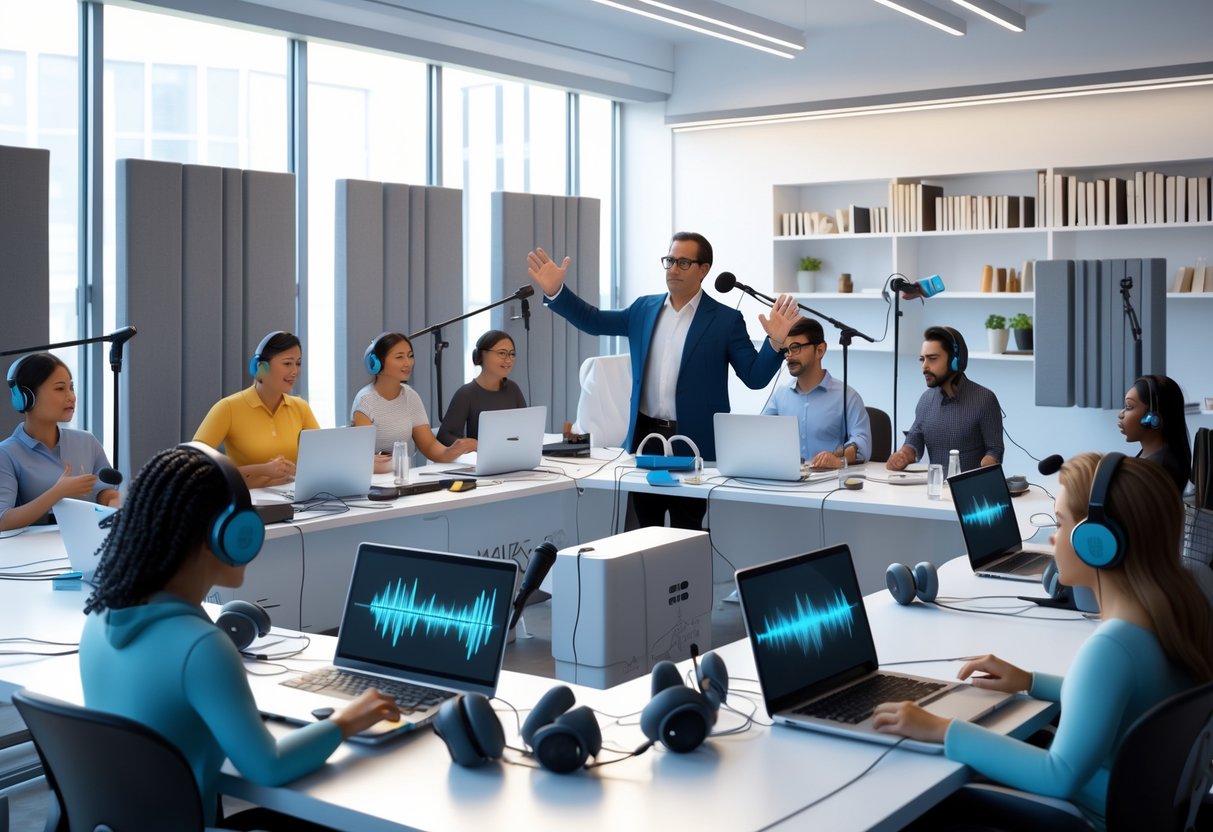
Voice training workshops give you a structured place to learn, practice, and get feedback from pros. These programs mix group sessions with personal coaching to help you build confidence and technical skills.
Types of Voice Training Workshops
Commercial and Animation Workshops are the backbone of most training programs. They teach you the skills you’ll need for casting in esports commentary and streaming.
The Voicecaster runs workshops for commercials, animation, video games, and accent work. They’ve got options for beginners and pros, both in-person and online.
Digital Training Courses are great if you’ve got a busy schedule. These let you learn at your own pace while still getting professional instruction.
Popular formats include:
- Live group sessions with 4-8 people.
- Intensive weekend courses (12-16 hours total).
- Weekly classes that last 6-12 weeks.
- Virtual workshops over video calls.
Most workshops cover recording practice, script analysis, and mic technique. You’ll get personalized feedback and advice on building your demo reel.
Benefits of Group and Private Coaching
Group workshops let you learn alongside others. You can see different approaches and get feedback from peers. It’s less pressure and helps build your confidence.
You’ll also meet people in the voice acting community. These connections can lead to future gigs or support down the road.
Private coaching is all about you. One-on-one sessions help you fix specific issues and improve faster.
Why go private?
- Custom lessons for your goals
- Immediate feedback
- Flexible scheduling
- Targeted skill-building for your niche
A lot of people start with group workshops, then move to private coaching as they get more advanced.
Notable Instructors and Programs
The Voicecaster is America’s oldest voiceover casting house. With more than 30 years in the business, they’ve helped launch a ton of voice acting careers.
Kelly Moscinski, The Voicecaster’s Head of Casting, leads their digital courses. Her lessons cover the basics of the industry and what casting directors expect.
Most established programs offer:
- Industry connections with casting directors
- Demo reel production and advice
- Ongoing career support
- Source Connect training for remote work
Heads up: Workshops won’t guarantee you a job or agent. You’ll need to practice, have a strong demo, and keep marketing yourself to make it.
The best programs are honest about how competitive this field is and how much work it takes to succeed.
Mastering Voiceover Technology
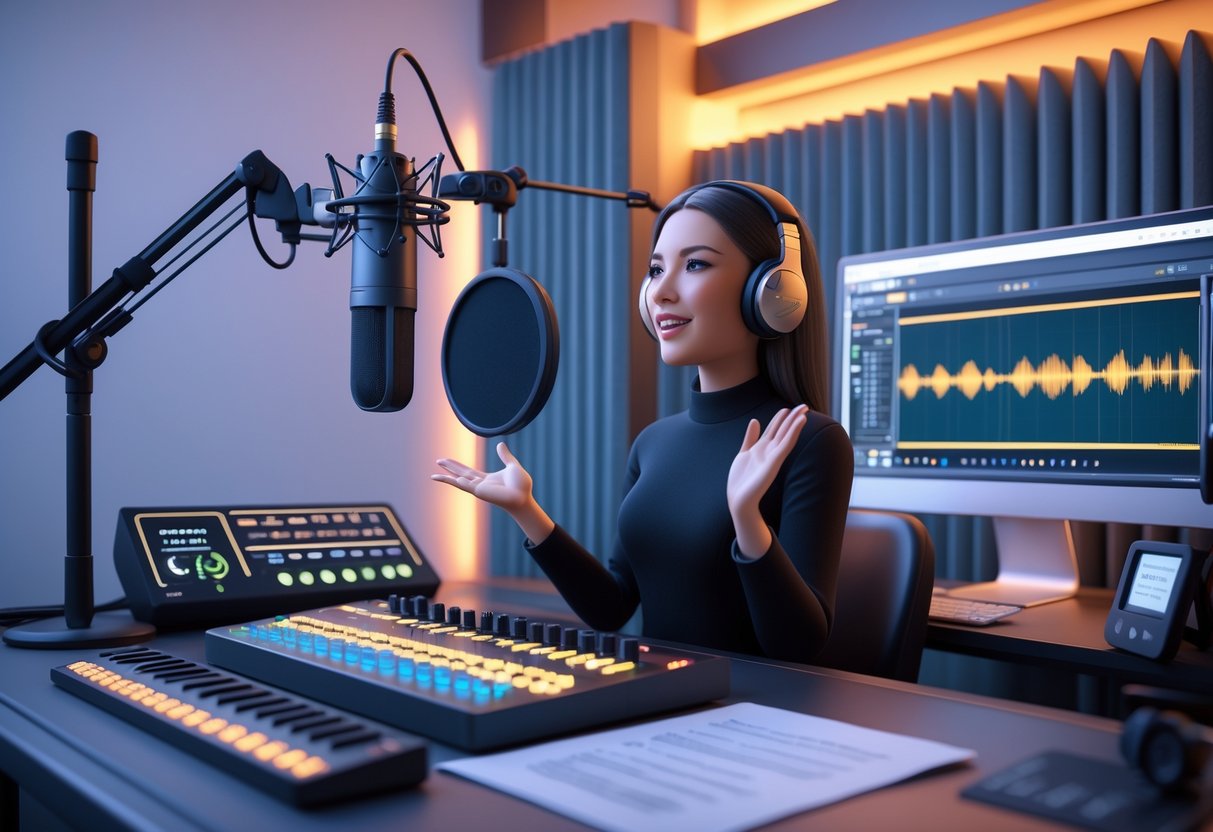
Your tech setup can make or break your voiceover career. You need to record clear audio at home and deliver files that casting directors actually want to listen to. Let’s talk about essential equipment, setting up a home studio, and editing skills that separate you from the amateurs.
Setting Up a Home Recording Studio
Your recording space matters more than fancy gear. Pick the quietest room you can find—carpet and soft furniture help absorb sound.
Tips for picking a spot:
- Stay away from rooms with hard surfaces like kitchens.
- Try recording at different times to check for outside noise.
- A walk-in closet full of clothes often works surprisingly well.
You can make a vocal booth with moving blankets or acoustic foam. Hang them behind and beside you. Some folks just throw heavy blankets over a clothes rack—it works!
Quick fixes for better sound:
- Drape a thick duvet behind your mic.
- Face into a corner with soft things around you.
- Use a reflection filter on your mic stand.
Keep your recording setup the same every time. Mark your mic spot with tape and use the same distance. This gives your work a consistent sound, which casting directors appreciate.
Recommended Equipment
You don’t need to spend a fortune to sound professional. A solid USB mic, closed-back headphones, and free recording software can get you started for under £200.
Here’s a basic gear list:
- Microphone: Audio-Technica AT2020USB+ (£169) or Rode PodMic USB (£199)
- Headphones: Sony MDR-7506 (£89) or Audio-Technica ATH-M40x (£99)
- Pop filter: Cuts down on plosives (£15-25)
- Boom arm: Keeps your mic steady (£25-40)
| Equipment Type | Budget Option | Professional Option |
|---|---|---|
| Microphone | Blue Yeti (£89) | Neumann TLM 103 (£1,200) |
| Audio Interface | Built-in USB | Focusrite Scarlett Solo (£109) |
| Software | Audacity (Free) | Pro Tools (£24/month) |
Don’t buy everything at once. Learn your basic setup, then upgrade as you go.
Editing and Submitting Recordings
Editing is where you can really shine. Most casting directors want clean, natural audio—no heavy effects.
Editing basics:
- Cut out mouth clicks and background noise.
- Normalize levels to -3dB peak.
- Add 0.5-1 second of room tone at the start and end.
- Export as WAV or AIFF files at 44.1kHz/16-bit or higher.
Make yourself a checklist so you don’t miss anything. A simple Excel sheet can help you track settings, export formats, and client requests.
Naming your files: Go with something like “YourName_ProjectName_Take1.wav” so it’s clear and easy to find.
Always send files in the format requested. Some want MP3s for fast review; others insist on broadcast-quality WAVs. Double-check the brief before sending anything.
The Importance of Mindset and Motivation

Mindset plays a huge role in caster voice training. How you handle rejection, push through tough practice, and keep yourself motivated makes all the difference in esports commentary.
Building Confidence as a Voice Actor
Confidence really starts with solid prep and practice. You’ve got to know your material—game mechanics, team histories, player stats—before you even think about going live.
Practice in low-pressure situations first. Record yourself commentating on replays or highlight reels. Listen back and spot areas to improve, but don’t stress about perfection.
Set up a pre-casting routine that gets you in the right mood. Try vocal warm-ups, review key points, or just hype yourself up with positive self-talk.
Your voice is your own—embrace what makes it different. You don’t have to sound like the big-name casters to succeed. Audiences connect with authenticity, not imitation.
Keep track of your progress. Save old recordings and compare them to your latest work. Seeing real improvement builds genuine confidence.
Start small. Try 10-15 minute practice sessions before tackling longer broadcasts. It’s way less intimidating.
Overcoming Common Challenges
Rejection hits everyone at some point. Most gigs go to established talent at first, but that doesn’t mean you should take it personally. It’s just how the industry works.
Tech issues are going to happen. Audio glitches, stream hiccups, broken gear—you name it. Have backup plans and practice staying cool when things go wrong.
Voice fatigue is real, especially during long tournaments. Learn to breathe properly, drink plenty of water, and schedule breaks.
Imposter syndrome creeps up on everyone, even veterans. Remember, everyone started somewhere. Focus on getting better, not on measuring up to others.
Feeling like you don’t know enough? No one knows everything right away. Build good research habits and chip away at your knowledge, bit by bit.
Negative feedback can sting, but it’s often useful. Take constructive criticism to heart, and ignore trolls. Use real feedback to get better, not to beat yourself up.
Daily Motivation Techniques
Set specific, measurable goals. Instead of something vague like “get better at casting,” try aiming for “complete three 20-minute practice sessions this week” or “learn five new terms for this game.”
Track your practice time with a simple log or app. Watching your effort add up over days and weeks really keeps you going when things get tough.
Connect with other aspiring casters. Online communities and Discord servers bring support, feedback, and motivation from people who know exactly what you’re dealing with.
Study professional casters actively. Watch matches with the sound on, then rewatch with it off and try commentating yourself. You’ll quickly spot gaps in your knowledge and technique.
Celebrate small victories. Maybe you finally explained a tricky play, kept your energy up during a marathon match, or got some positive feedback—those moments matter.
Maintain physical health. Regular exercise, proper sleep, and good nutrition all boost your vocal performance and mental clarity. Physical and mental prep really go hand-in-hand here.
Create accountability systems. Share your goals with friends, family, or an online group. Regular check-ins help you stay on track, especially when motivation dips.
Career Development in the Voice Over Industry
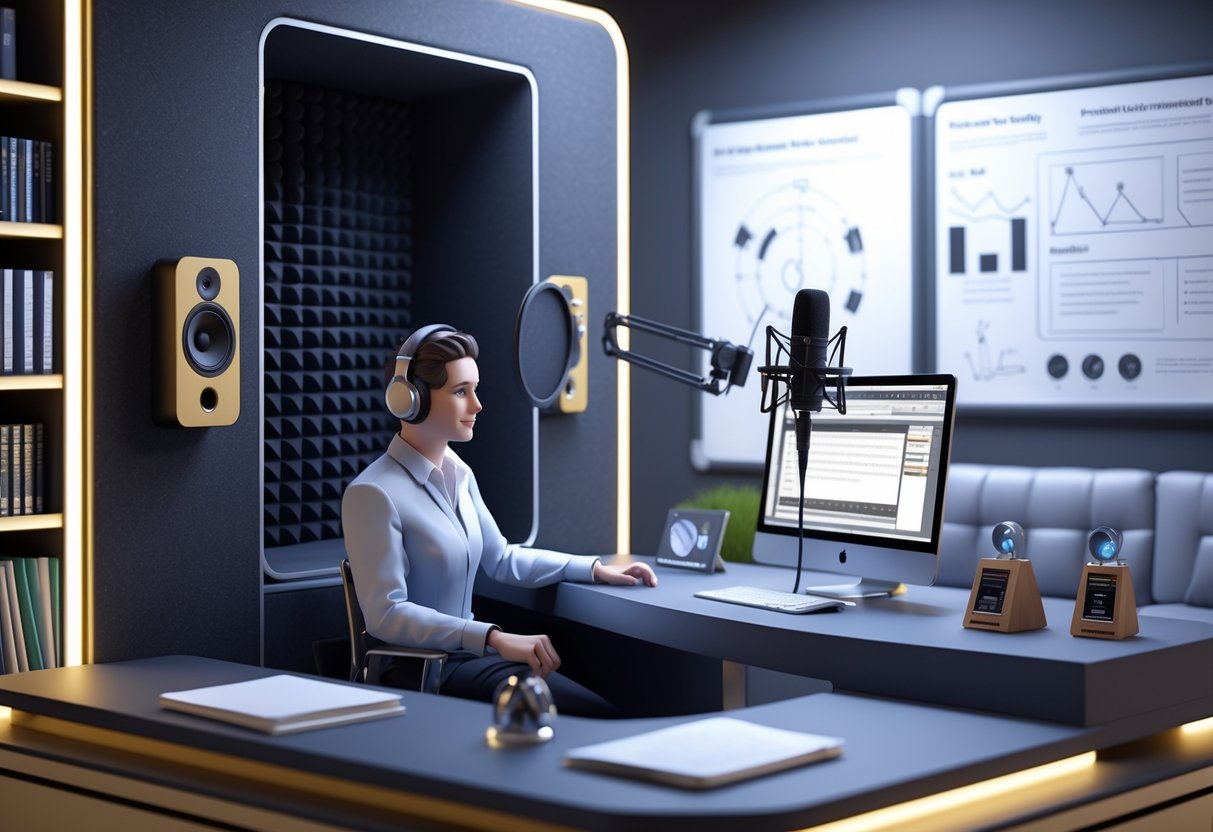
Building a voice acting career takes strategic marketing, professional representation, and strong industry connections.
You get ahead by treating your voice work like a business and building relationships that lead to new opportunities.
Marketing Yourself as a Voice Actor
Your voice acting journey really kicks off with smart marketing. You’ll need a professional demo reel that shows off your range across styles and genres.
Build a strong online presence using social media and a solid website. Share behind-the-scenes moments and interact with potential clients often.
Create marketing materials that fit each market you want to work in. Commercial gigs need different samples than video games.
Key marketing tools include:
- Professional headshots
- Demo reels (60-90 seconds each)
- Business cards with QR codes
- Social media profiles
- Professional website
Keep track of your marketing efforts. Note which methods actually bring auditions and bookings.
Quick tip: Update your materials every 12-18 months. Your skills grow, and clients want to see what’s new.
Navigating Representation and Agents
Voice acting agents can speed up your career by connecting you to better-paying jobs. They handle negotiations and look out for your interests.
Start building relationships before you actually need an agent. Go to industry events and workshops where agents scout new talent.
Research potential agents carefully. Find ones who specialise in your voice type and target markets. The Voicecaster, around since 1975, represents all sorts of voice actors.
Agents usually take a 10-20% commission. That cut often pays off with higher rates and steadier work.
Before reaching out to agents:
- Prepare professional demos
- Build a history of bookings
- Learn standard industry rates
- Practice your pitch
Some voice actors sign with multiple agents in different regions. This can open more doors without causing conflicts.
Networking for Success
Voice acting runs on relationships. Strong connections often lead to repeat work and referrals.
Join professional organisations like Voice123 or casting director workshops. These give you structured networking opportunities.
Connect with other voice actors, too—not just clients. Peers often refer gigs they can’t take or share helpful industry tips.
Effective networking strategies:
- Attend industry conferences
- Join online voice acting communities
- Follow up after meetings
- Offer help before asking for favours
Keep up with your contacts. Send holiday cards, celebrate others’ wins, and stay on their radar.
Heads up: Don’t oversell yourself at networking events. Focus on building real professional relationships first.
Advanced Tools: Voice Control and Coding Skills

Caster takes basic voice training and turns it into powerful development workflows. It connects with major programming languages and automates tricky tasks with spoken commands.
Using Caster for Workflow Automation
Caster lets you ditch keyboard shortcuts for natural voice commands. You can control apps, manage windows, and move through text—no mouse or keyboard needed.
The universal navigation system works in every program. Say “window right” to shove your active window to the right. “Shackle” grabs a whole line of text in one go.
Essential workflow commands:
- Text manipulation: “prekris” drops in brackets and puts your cursor inside
- Window management: Use voice to move or resize windows
- File operations: Navigate dialogue boxes and manage documents hands-free
Caster activates app-specific modules as you switch programs. In Sublime Text, “find” hits Ctrl+F for you. “Edit next 3” grabs the next three instances of your chosen word.
These commands cut down on repetitive strain and help you code faster. Many developers say they get twice as much done after mastering Caster’s workflow automation.
Voice Coding for Developers
You can access programming languages through spoken syntax commands. Just say “enable python” or “enable java” to turn on shortcuts for that language.
Python devs use “for loop” to insert for i in range(0, ): automatically. “Print to console” creates a properly formatted print() statement.
Language-specific features:
- Python: File handling, loops, functions
- Java: Class templates, methods, imports
- C++: Pointers, memory management, templates
- JavaScript: DOM work, events, async functions
Caster understands what’s happening in your code. It tells the difference between variables, functions, and control structures. That cuts down on the voice recognition mistakes you get with generic dictation tools.
The system keeps up with chained commands, so you don’t have to pause between statements.
Integrations with Go, Rust, and R
Modern language support now covers Go, Rust, and R through Caster’s expandable setup. Each language module brings voice commands tailored to what makes that language unique.
Go integration lets you work with goroutines, channels, and packages. Voice commands handle Go’s unique syntax, like interface declarations and struct methods.
Rust support covers ownership and memory safety. Commands generate correct borrowing syntax and handle Rust’s error management with your voice.
R integration targets statistical work. You can manipulate data frames, run stats functions, and plot data—all streamlined for analysis.
These modules work with tools like GitBash, command prompts, and different IDEs. The system recognises when you switch languages and changes commands on the fly.
Third-party extensions add even more. Autohotkey speeds up common tasks, and Sikulix brings visual automation for complex environments.
Success Stories from Voice Training Alumni

The Voicecaster has shaped countless careers over three decades. Our graduates land big commercial gigs and sign with top agents.
Featured Graduates
Kelly Moscinski’s training programs have launched voice actors into successful careers in all kinds of industries. Our alumni work on everything from TV ads to video game characters.
A lot of them started with zero experience. They built up their skills in our workshops and coaching sessions. Now, they book steady work with major brands.
One graduate shifted from podcasting to creating online courses. He wanted more passive income, and our video training helped him branch out from just audio.
Another alumnus started in university theatre and added our Edge Studio coaching. Now they juggle multiple private coaches and keep landing voice-over jobs.
The range of backgrounds is wild—some come from acting, others from totally unrelated fields.
Real-world Casting Achievements
Our alumni work with household names. Recent gigs include Papa John’s, Cap’n Crunch, and Popeyes commercials.
Kelly Moscinski casts for major clients like Verizon, Walmart+, Google, and Amazon. Our trained voice actors compete for—and win—these top jobs.
Video games are another big area. Alumni have voiced roles in Dungeons & Dragons and Ready or Not.
There’s work in every genre:
- Commercial: TV and radio ads
- Animation: Cartoons and animated films
- Video games: Characters and narration
- Corporate: Training videos and presentations
Many graduates sign with voice-over agents, which opens doors to bigger projects and steadier income.
Testimonials from the Voicecaster Community
Kim Wilson, voice actor and podcast co-host, calls Kelly “approachable, relatable, and refreshingly honest.” She says it feels like having “a trusted mentor by your side.”
Jennifer Sims, a Los Angeles voice actor and coach, recommends our training for newcomers. She describes our lab as “clear, comprehensive” and says it “answers so many questions newer voice actors face.”
Students appreciate the step-by-step guidance toward professional careers. The modules break down complex business stuff into manageable pieces.
Business training matters as much as technique. Our marketing seminars and agent workshops fill knowledge gaps that trip up many voice actors.
Students get real-time feedback from experienced casting pros. This simulates real audition conditions. They learn what casting directors want to hear before they ever start auditioning for real.
Frequently Asked Questions
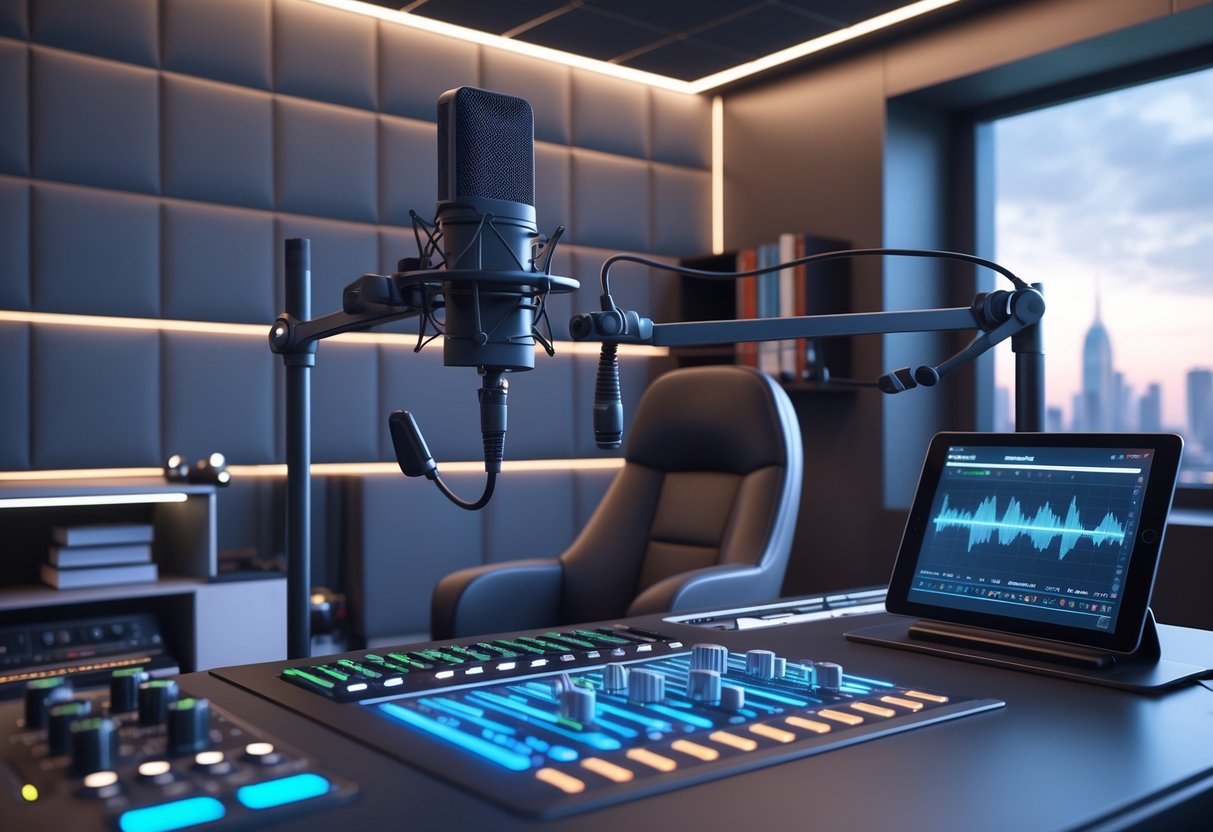
Voice clarity, articulation exercises, and breathing techniques build the foundation for effective caster training.
Proper vocal warm-ups and consistent practice help you develop the stamina you’ll need for long commentary sessions.
How can I improve the clarity of my speech for casting?
Focus on hitting consonants clearly and keeping your mouth in the right position. Try speaking with a pencil between your teeth for 10 minutes a day—it really strengthens those articulation muscles.
Record yourself reading match commentary and listen for any mumbled words or rushed lines. Slow your speaking pace by about 10% during practice.
Work on opening your mouth wider as you talk. Lots of casters lose clarity because they don’t give enough space for clean vowel sounds.
What exercises can help with articulation when training for voice casting?
Tongue twisters are classic for a reason. Try tricky phrases like “red leather, yellow leather” ten times in a row.
Practice the “ma-may-my-mo-moo” sequence for five minutes daily. It helps you hit different mouth shapes and transition smoothly between sounds.
The cork exercise works too—put a wine cork between your teeth and read out loud for ten minutes. Take the cork out and notice how much clearer your speech is.
Are there specific vocal warm-ups that benefit commentators and announcers?
Lip trills and humming get your vocal cords ready for long sessions. Spend five minutes doing gentle lip bubbles before you cast.
The “ng” sound exercise relaxes your throat muscles. Say “sing-song” over and over, focusing on the vibration in your nose and throat.
Voice sirens are great for range. Start at your lowest comfortable pitch, glide to your highest, then back down.
What’s the best way to increase stamina for long casting sessions?
Build vocal endurance slowly by adding 15 minutes to your practice each week. Start with 30-minute sessions and work up to three hours.
Stay hydrated all day, not just when you’re casting. Aim for 2-3 litres of water, and skip caffeine and alcohol before long sessions.
Practice speaking from your diaphragm, not your throat. Put one hand on your chest and one on your stomach—only the lower hand should move when you breathe right.
Can you suggest any breathing techniques for maintaining voice control during live commentary?
The 4-7-8 technique works in short pauses during gameplay. Inhale for 4 counts, hold for 7, and exhale for 8 through pursed lips.
Try tactical breathing during breaks in commentary. Take quick diaphragmatic breaths during loading screens or replays.
Keep your airflow steady by maintaining good posture. Sit up straight, feet flat, shoulders relaxed.
How often should I practise my voice exercises to see a noticeable improvement in my casting?
Try practising every day for about 20-30 minutes. You’ll probably see the biggest changes in 4-6 weeks, but honestly, it’s sticking with it that really pays off—not just grinding out long sessions.
I like to split my routine: morning vocal warm-ups, then articulation drills in the evening. That way, I avoid burning out my voice and still keep making progress.
Record yourself once a week so you can actually hear how you’re improving. Most casters pick up on clearer speech after just three weeks if they keep at it.


